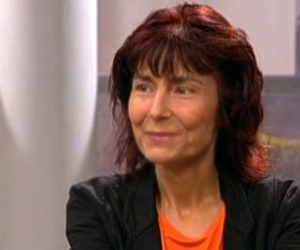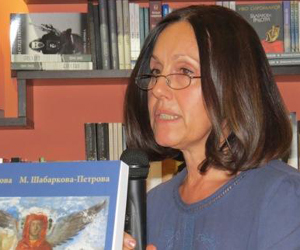The second volume of a remarkable book was presented at The Plume club at the National Palace of Culture in Sofia – The Mystery of Bulgarian frescoes. The volume itself is entitled Sacred history and history and was released by Inle publishers which also published the first volume – Touching God. Authors are Dr. Vesselina Vachkova, expert in ancient and medieval history and culture and lecturer at the National Academy of Art and the National High School of Ancient Languages and Cultures and publisher Mariana Shabarkova-Petrova, author of More than 100 remarkable monasteries in Bulgaria. She has also translated historical monographs from French into Bulgarian and vice versa. The idea for this book was born after years of research by the two ladies individually, inside the country and abroad.
 “The second volume aims to present, literally, the “dialects” in ecclesiastical painting that have asserted themselves with the passage of time. In what sense?", Vesselina Vachkova explains. "To begin with, it literally follows the maxim “Painting is the bible for the illiterate”. And it is not just Pope Gregory the Great who said it. And as it is a bible to them, to begin with everything was painted: Old Testament, New Testament, up to the 12th century we can see every scene possible. After the 12th century East and West diverge tangibly for the simple reason that the East, especially after the iconoclasm, categorically refused to depict images from the Old Testament. (Iconoclasm is a 13th-14th century religious and political movement in Christianity that opposes the widespread homage of icons and relics and their commercialization).
“The second volume aims to present, literally, the “dialects” in ecclesiastical painting that have asserted themselves with the passage of time. In what sense?", Vesselina Vachkova explains. "To begin with, it literally follows the maxim “Painting is the bible for the illiterate”. And it is not just Pope Gregory the Great who said it. And as it is a bible to them, to begin with everything was painted: Old Testament, New Testament, up to the 12th century we can see every scene possible. After the 12th century East and West diverge tangibly for the simple reason that the East, especially after the iconoclasm, categorically refused to depict images from the Old Testament. (Iconoclasm is a 13th-14th century religious and political movement in Christianity that opposes the widespread homage of icons and relics and their commercialization).
Special attention is given to two things, Vesselina Vachkova goes on to say. One is how the history of Christian communities is interpreted in ecclesiastical art, for example the ecumenical councils:
 “Ecumenical councils are perhaps the most important event right up to the year 843 (when iconoclasts were excommunicated), as it is the councils that create the theology of Christianity. Until that time there was just one symbol of the faith, a very simple symbol that does not provide answers to all of the questions believers have. The other thing treated by the book is the approach to church donors and rulers. The big difference between East and West is that here, in this part of the world secular history never had any contact with religious history, there was always a certain distance. For example, if there is a Nativity scene, there can never be a church donor in the picture. The donor can be depicted quite separately. Why? Because that is a way to make sure no sovereign or ruler shall be deified. Authority shall always be to one side. In this sense one of the lines we trace in this volume is a theology in pictures that is definitely Bogomil, an openly Bogomil theology adapted from the official church.”
“Ecumenical councils are perhaps the most important event right up to the year 843 (when iconoclasts were excommunicated), as it is the councils that create the theology of Christianity. Until that time there was just one symbol of the faith, a very simple symbol that does not provide answers to all of the questions believers have. The other thing treated by the book is the approach to church donors and rulers. The big difference between East and West is that here, in this part of the world secular history never had any contact with religious history, there was always a certain distance. For example, if there is a Nativity scene, there can never be a church donor in the picture. The donor can be depicted quite separately. Why? Because that is a way to make sure no sovereign or ruler shall be deified. Authority shall always be to one side. In this sense one of the lines we trace in this volume is a theology in pictures that is definitely Bogomil, an openly Bogomil theology adapted from the official church.”
The first volume of The Mystery of Bulgarian frescoes came out two years ago. It is dedicated to the New Testament and takes a look at the way New Testament stories are treated by Bulgarian iconography. The second volume which came out recently looks at the Old Testament stories. This part is entitled Sacred history and history. “That is to say we have the sacred history of the bible but we also treat the history of Bulgaria as it is depicted in icons and frescoes,” says Mariana Shabarkova-Petrova and adds:
 “I would like to say what makes the book unique. First, it has two authors, myself and Vesselina Vachkova, a foremost Medievalist. It has been an honour and a pleasure to have worked with her. Another thing that makes the book unique us that it is based on a huge archive that I have collected over some 20 years from my travels to monasteries and churches. The approach in it is also very distinct – it makes a comparative analysis of frescoes in Bulgaria and in other counties. We have endeavoured to emphasize that Bulgarian frescoes are incredibly meaningful and in many aspects even more interesting than frescoes in Western Europe. We also highlight the fact that in Bulgarian frescoes very often, if not always, we have some element from antiquity, some foundation that goes deep into our roots which Bulgarian iconographers have transferred in their own work. And this is something unique to Bulgarian icon painting.”
“I would like to say what makes the book unique. First, it has two authors, myself and Vesselina Vachkova, a foremost Medievalist. It has been an honour and a pleasure to have worked with her. Another thing that makes the book unique us that it is based on a huge archive that I have collected over some 20 years from my travels to monasteries and churches. The approach in it is also very distinct – it makes a comparative analysis of frescoes in Bulgaria and in other counties. We have endeavoured to emphasize that Bulgarian frescoes are incredibly meaningful and in many aspects even more interesting than frescoes in Western Europe. We also highlight the fact that in Bulgarian frescoes very often, if not always, we have some element from antiquity, some foundation that goes deep into our roots which Bulgarian iconographers have transferred in their own work. And this is something unique to Bulgarian icon painting.”
English version: Milena Daynova
After nearly 35 years, the Bulgarian Orthodox Church Community in London has its own church in the central part of the British capital, in close proximity to the Bulgarian Embassy. There, in the prestigious Kensington district, next to Hyde Park and..
Meatfare Sunday in 2025 will be remembered as a major celebration for the Bulgarian Orthodox Church and the entire Bulgarian community in the United Kingdom. The "St. John of Rila" Orthodox Church, built with funds from the Bulgarian state and with..
All Souls' Day (Zadushnitsa in Bulgarian) is an important day for many Christians. On this day, we remember deceased relatives and loved ones. The first of the three All Souls' Days of the year, also known as the Great or All Souls' Day, falls on the..
Meatfare Sunday in 2025 will be remembered as a major celebration for the Bulgarian Orthodox Church and the entire Bulgarian community in the United..
After nearly 35 years, the Bulgarian Orthodox Church Community in London has its own church in the central part of the British capital, in close proximity..

+359 2 9336 661
